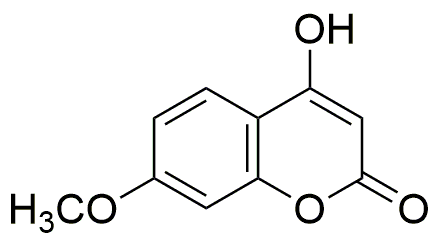4-Hydroxy-7-methoxycoumarin is widely utilized in research focused on:
- Fluorescent Probes: This compound is often used as a fluorescent marker in biological research, enabling scientists to visualize cellular processes and track molecules in live cells.
- Antioxidant Studies: Its antioxidant properties make it valuable in studies investigating the effects of oxidative stress in various diseases, providing insights into potential therapeutic applications.
- Pharmaceutical Development: This chemical serves as a lead compound in the development of new drugs, particularly in the field of cancer research, due to its ability to inhibit specific enzymes involved in tumor growth.
- Cosmetic Formulations: It is incorporated into skincare products for its skin-protective properties, helping to prevent damage from UV radiation and promoting overall skin health.
- Food Industry: The compound is used as a natural food additive, providing flavor and color while also contributing to the preservation of food products due to its antioxidant capabilities.
General Information
Properties
Safety and Regulations
Applications
4-Hydroxy-7-methoxycoumarin is widely utilized in research focused on:
- Fluorescent Probes: This compound is often used as a fluorescent marker in biological research, enabling scientists to visualize cellular processes and track molecules in live cells.
- Antioxidant Studies: Its antioxidant properties make it valuable in studies investigating the effects of oxidative stress in various diseases, providing insights into potential therapeutic applications.
- Pharmaceutical Development: This chemical serves as a lead compound in the development of new drugs, particularly in the field of cancer research, due to its ability to inhibit specific enzymes involved in tumor growth.
- Cosmetic Formulations: It is incorporated into skincare products for its skin-protective properties, helping to prevent damage from UV radiation and promoting overall skin health.
- Food Industry: The compound is used as a natural food additive, providing flavor and color while also contributing to the preservation of food products due to its antioxidant capabilities.
Documents
Safety Data Sheets (SDS)
The SDS provides comprehensive safety information on handling, storage, and disposal of the product.
Product Specification (PS)
The PS provides a comprehensive breakdown of the product’s properties, including chemical composition, physical state, purity, and storage requirements. It also details acceptable quality ranges and the product's intended applications.
Certificates of Analysis (COA)
Search for Certificates of Analysis (COA) by entering the products Lot Number. Lot and Batch Numbers can be found on a product’s label following the words ‘Lot’ or ‘Batch’.
Numéro de catalogue
Numéro de lot/série
Certificates Of Origin (COO)
This COO confirms the country where the product was manufactured, and also details the materials and components used in it and whether it is derived from natural, synthetic, or other specific sources. This certificate may be required for customs, trade, and regulatory compliance.
Numéro de catalogue
Numéro de lot/série
Safety Data Sheets (SDS)
The SDS provides comprehensive safety information on handling, storage, and disposal of the product.
DownloadProduct Specification (PS)
The PS provides a comprehensive breakdown of the product’s properties, including chemical composition, physical state, purity, and storage requirements. It also details acceptable quality ranges and the product's intended applications.
DownloadCertificates of Analysis (COA)
Search for Certificates of Analysis (COA) by entering the products Lot Number. Lot and Batch Numbers can be found on a product’s label following the words ‘Lot’ or ‘Batch’.
Numéro de catalogue
Numéro de lot/série
Certificates Of Origin (COO)
This COO confirms the country where the product was manufactured, and also details the materials and components used in it and whether it is derived from natural, synthetic, or other specific sources. This certificate may be required for customs, trade, and regulatory compliance.


